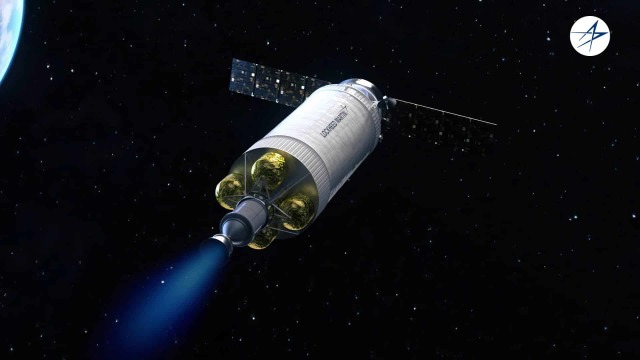Two American agencies, which are invariably associated with the most fantastic innovations, have signed a contract for the production of a nuclear rocket engine with contractors. The NASA and DARPA project now has a time frame for implementation, a dedicated budget and the names of contractors.
The most modern state program for the development of a practically applicable thermal nuclear rocket engine (NTP) is called DRACO — Demonstration Rocket for Agile Cislunar Operations, that is, literally "Demonstration Rocket for flexible lunar Operations". The project has been discussed for a long time, and finally it got its final look. Last January, the US National Aeronautics and Space Administration (NASA) and the Office of Advanced Research Projects of the US Department of Defense (DARPA) signed the final version of the agreement ( PDF ) on the implementation of DRACO.
The next step was to select contractors to manufacture all the necessary elements — first of all, the reactor and the engine. This most important task, as reported by SpaceNews with reference to press releases of departments, was assigned to Lockheed Martin. More precisely, the "space" division of the corporation, located in the city of Littleton, Colorado. The eminent company will not work on the reactor alone — BWX Technologies will add its expertise in the field of nuclear energy. This name is familiar to nuclear scientists, but less public than Lockheed.
The "star team", under the strict supervision of NASA and DARPA (and with their authoritative help, of course), will have to produce a prototype in less than four years. The planned launch date of DRACO for the first flight is 2027. The timing is preliminary, because in the space industry, and in the nuclear industry, projects rarely went on schedule. But the indicated pace of work is impressive. And, curiously, the budget is very modest — $ 499 million, both government departments will split the funding in half.
It is worth noting that a ridiculous amount by modern standards for such a fundamental project is not final. As is customary in the XXI century, space developments follow the principle of public-private co-financing with the expectation of subsequent commercialization of the development. Both key contractors — Lockheed Martin and BWX Technologies — will spend their own funds on development. However, their volume, even approximate, is not disclosed. In addition, NASA has already allocated an additional $ 50 million in the budget for internal project support, technical expertise and other consultations.
©Lockheed MartinNASA called for "aggressively" developing space nuclear reactors for traveling to Mars For comparison, the NERVA nuclear rocket engine, brought to ground tests in the late 1960s, according to NASA estimates, should have cost the budget almost a billion dollars (more than eight billion in 2023, adjusted for inflation). But NERVA was tested on Earth, and no one dared to launch it into space.
DRACO has a different fate in store for him — he will immediately go into orbit. And it's not about increased courage, it's just more profitable. NASA's project manager in the field of space atomic technologies Anthony Calomino said that the agency was working on different options, but in the end, it is more expensive and less safe to conduct fire tests of NTP on Earth.
There is no final appearance of a ready-made technology demonstrator yet, there is only a preliminary vision of it. This is a spacecraft the size of a "typical upper stage", fitting under the payload fairing.
After launch, DRACO will enter a working orbit with an altitude between 700 and 2000 kilometers, where the engine testing program will begin. There, the device will have to function in different modes for a couple of months until the working fluid — liquefied hydrogen - runs out.
The option of refueling in orbit is being considered, but its implementation depends on how the technology of docking satellites and pumping cryogenic liquids between them will develop. We recall that Lockheed Martin is actively engaged in it for the Blue Moon lunar lander developed by Blue Origin.
The theoretical efficiency of a thermal nuclear rocket engine (NTP), its specific impulse, reaches 900 seconds. For comparison, the best chemical rocket engines barely get close to 470 seconds, and more often do not go beyond 400 seconds. This is a significant advantage of NTP, but it still needs to be confirmed. The DRACO target is more modest, about 700 seconds, because efficiency is not important for the demonstrator. Video documentary by NASA and the US Atomic Energy Commission about nuclear rocket engines, which includes footage of the assembly, testing and testing of NERVA (starting at 7:00 and onwards) / ©US National Archives
Within the framework of DRACO, no large-scale maneuvers or flights beyond low Earth orbit are planned. The main task of the device is to show that a reactor with high—enrichment fuel can work in space. Not three to five percent, as in conventional nuclear power plants (low-enriched, LEU), but up to 20 percent, it is called High-assay LEU (HALEU), LEU with a high content of samples. In the past, all space nuclear reactors operated on highly enriched fuel (more than 85 percent of U-235).
Industry representatives and officials have high hopes for the DRACO project. This is a relatively simple nuclear rocket engine, the development of which technologies can open up broad prospects for space exploration. And it's not just about flights — the start of operation of reactors in engines will indirectly or directly help their use for bases on other celestial bodies.
For NASA, DRACO's success is a critical milestone on the way to Mars exploration after "training" on the moon. The military, represented by DARPA, in turn, wants to have high-energy reconnaissance vehicles for operations outside Earth orbit. Well, Lockheed Martin and BWX Technologies risk becoming the most competent companies in the field of space nuclear installations and securing a promising market in advance.

